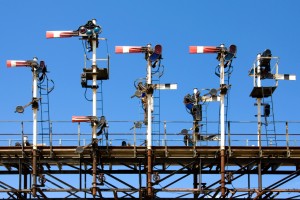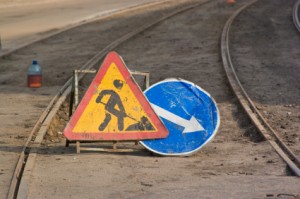Dangerous Railroading
Until a year ago, my professional railroading career as Class I management and an independent consultant had been almost totally dedicated to the freight industry of North America. There have been some interesting consulting engagements outside of that sphere, including a most peculiar investigation (I never knew who the true client was) into the traffic control and communication systems for railroads in the Middle East and Southeast Asia 25 years ago. But I was taken by surprise, actually shocked, when I read about the initiation of a study in that same corner of the world that would evaluate the safety and efficiency of a local railroad operation. It seems I didn’t really know what I thought I knew.
Having been nurtured for 36 years in the U.S. railroads, I had come to understand that operating a railroad safely requires disciplined allegiance to 1) safety systems, 2) maintenance practices, and 3) personal accountability. And, slack in any one of these three areas could readily result in the safety of a railroad’s operations being severely compromised. Hence, it was with the greatest dismay that I soon realized upon starting the study for the troubled railroad (hereon referred to as TRR), that it was suffering in all three areas as well as a fourth issue – the theft of critical wayside infrastructure. Given these significant problems, there have been a number of deadly train accidents across TRR, and there will continue to be unless all four areas are addressed properly. Thus, the focus of the TRR study was clearly directed to be that of safety first, and then efficiency.
The slap-across-the-face revelation for me was that TRR is NOT unique. Its dangerous railroading practices and problems are common in many parts of the world. Given the importance of railroads to emerging economies as providers of labor mobility and accelerators of industrialization – these safety and operating issues have far-reaching impacts. Thus, I have shifted the emphasis of my consulting to now focus on what railroads can do to address these 4 critical areas. In this post, I provide a brief description of each problem area as observed from my experience with TRR. Some readers will likely see similarities to their own operations . . . or their clients. Additionally, as will be addressed in subsequent postings, I will identify non-traditional, cost-effective and 100% safe solutions for each of the 4 areas. These are solutions that are not being provided by traditional suppliers that focus on the high speed passenger and/or high density freight networks across the globe. The solutions have to be non-standard / non-traditional since traditional suppliers produce and price for high speed/high density lines and these solutions can in fact result in a financial disaster for small and emerging railroads while increasing the likelihood of additional risk in their operations.
SAFETY SYSTEMS

There are two primary levels of safety systems to consider in the movement of trains, i.e., traffic control and enforcement. TRR’s traffic control is a mixture of traditional signaling (i.e., a railroad’s traffic lights) and an antiquated token block operation. While the condition of the signaled operation across TRR is understood to be below par, it is TRR’s token block operation that requires the greatest attention.
Token block originates back in the middle of the 19th Century in Britain, and its deployment across the globe was in step with the expansion of the British Empire. Simply explained, token block’s safety, as used across TRR, is based upon an operator for each section of track (block) handing a token, e.g., metal rod, to the train crew as an authority to proceed into the block. Upon exiting the block, the train crew hands back the token to the next operator and at some point receives a new token unique to the next block. In concept, token block is a safe system. But, in practice the manual processes involving the block operator and the crew can be, and have been, violated resulting in fatal accidents. For this and perhaps other reasons, various types of Radio Electronic Token Block (RETB) have replaced manual token block in Britain and elsewhere, including a relatively short corridor in TRR. But for the majority of TRR’s operation that is still manual token block, the integrity of that operation is subject to being compromised by human error. Fortunately, as to be addressed in a forthcoming posting, there are non-signaling traffic control systems that can replace token block. These are solutions that don’t require the extensive capital investment of traditional CTC operations or the overwhelming capital investment of ETCS as used for Europe’s high speed rail networks.
Traffic control safety is not the only issue associated with safe train movements. There is also the issue of train crew errors regardless of whether the operation is in signaled territory or token block, and it is the purpose of enforcement systems to prevent such errors. In TRR’s case, an antiquated enforcement approach, Automatic Train Protection (ATP), is deployed across much of the railroad. However, based upon my visits to date, it appears that the maintenance and theft of ATP components embedded in the track as well as the train drivers turning off the on-board controller so as to not be enforced for over-speeding, has rendered the system highly ineffective. To be addressed in a latter posting, ATP is quite similar in functionality to another enforcement system referred to as Positive Train Control (PTC) that is now mandated for implementation before 2016 across most of the trackage in the U.S. PTC doesn’t have the theft, maintenance, and driver abandonment problems of TRR’s ATP system.
MAINTENANCE PRACTICES
 As suggested above, the adequateness and reliability of TRR’s maintenance procedures for wayside infrastructure and rolling stock are dubious. For the wayside infrastructure, TRR is confronted with an aging signaling system that is anticipated to have a major overhaul in the near future. However, much of the token block operation incorporates mechanical interlockings that, as with the token block equipment itself, are reportedly not up to grade. Such lack of maintenance is likely the result of two key issues. First, there is no regulatory process for providing mandatory maintenance procedures. Second, it is doubtful given just the physical appearance of the railroad overall, that governmental financial support has been anywhere near sufficient, if even budgeted.
As suggested above, the adequateness and reliability of TRR’s maintenance procedures for wayside infrastructure and rolling stock are dubious. For the wayside infrastructure, TRR is confronted with an aging signaling system that is anticipated to have a major overhaul in the near future. However, much of the token block operation incorporates mechanical interlockings that, as with the token block equipment itself, are reportedly not up to grade. Such lack of maintenance is likely the result of two key issues. First, there is no regulatory process for providing mandatory maintenance procedures. Second, it is doubtful given just the physical appearance of the railroad overall, that governmental financial support has been anywhere near sufficient, if even budgeted.
As to equipment, I reflect on a conversation I had with a TRR executive when I asked what he thought was the most unsafe part of his railroad. Without hesitation his answer was “The brakes.” I was then told that the goal of their operation at that time was to ensure that half of the cars (wagons) in a train’s consist were equipped with working brakes – with an additional challenge of ensuring that ½ of the brake-able cars were to be placed at the beginning and the end of each train so as to reduce in-train forces.
Outside of North America, Europe and the far East, many railroads are confronted with two critical parameters that affect their ability to perform proper traffic control and supporting infrastructure maintenance. First, there is the issue of an adequately-trained work force. However, that issue can be readily handled via the use of contractors. The second parameter is the topography over which the railroad operates, and the accessibility to the wayside as well as the availability of power. Again, solutions are available, but they can be quite expensive. The point here is that railroads subjected to such parameters should consider safety systems that minimize those requirements, i.e. minimize the amount of wayside infrastructure. However, traditional suppliers do not offer those types of systems to them – why would a supplier offer a system that has less equipment. A future posting will address this point.
PERSONAL ACCOUNTABILITY
As demonstrated by the discussion above, there is a critical lack of consistency in personal accountability across TRR in both the operations and maintenance of critical equipment. Perhaps this is due to the fact that TRR is a government-owned railroad with seemingly little incentive to address costs or revenues. Or, perhaps this is due to the lack of a regulatory body, such as the Federal Railroad Administration (FRA) in the U.S. that mandates and enforces proper procedures. Regardless of the reasons, it is clear that TRR, or any railroad, will not operate safely without a workforce totally committed to safety. To achieve that takes documented procedures, education / training, the right incentive system and discipline throughout the organization. A future posting will address these points.
THEFT
 While copper wire used for pole lines has been a favorite target of thieves in the U.S. over the years, the theft of other critical components has been minimal. However, in many parts of the world, everything is fair game apparently. The treasure chest includes signaling equipment, power supplies, and in-track transponders used by Europe’s advanced traffic control system for high speed rail, ETCS. The key point here is that, as with maintenance issues noted above, a railroad should consider the vulnerability to operations and safety due to theft of critical components when selecting from alternative safety systems. The only viable solution is a system with less infrastructure to steal – but again, what supplier in their right mind would sell a system with less equipment. A future posting will address these points.
While copper wire used for pole lines has been a favorite target of thieves in the U.S. over the years, the theft of other critical components has been minimal. However, in many parts of the world, everything is fair game apparently. The treasure chest includes signaling equipment, power supplies, and in-track transponders used by Europe’s advanced traffic control system for high speed rail, ETCS. The key point here is that, as with maintenance issues noted above, a railroad should consider the vulnerability to operations and safety due to theft of critical components when selecting from alternative safety systems. The only viable solution is a system with less infrastructure to steal – but again, what supplier in their right mind would sell a system with less equipment. A future posting will address these points.
In addition to the 4 areas above, there are other significant considerations as to safe train movement operations including the use of train-integrity detection in token block operation, end-of-train monitoring of brake line pressure, wayside defect detectors, and on-board car detection systems, e.g., fire detection and alarm systems for passenger operations.
Indeed, there are overwhelming issues with the safety of TRR’s operations. The study that is being performed by my colleagues and I, will address those issues as well as identify advanced traffic management concepts that will support TRR’s increasing requirement to mix freight with passenger service on critical corridors. I know now that there are many railroads across the globe that could benefit greatly, both as to safety and financial viability, by having such a study performed without prejudice to particular approaches, equipment, or suppliers. Such a study would take into consideration safety systems, maintenance practices, personal accountability, and theft, as well as the peripheral safety considerations mentioned above.
Your correspondence is most welcomed and encouraged.


